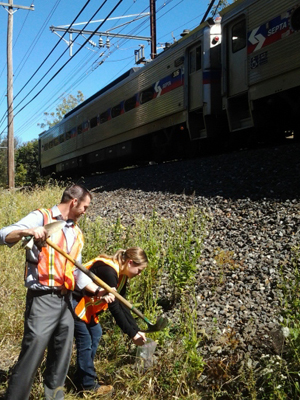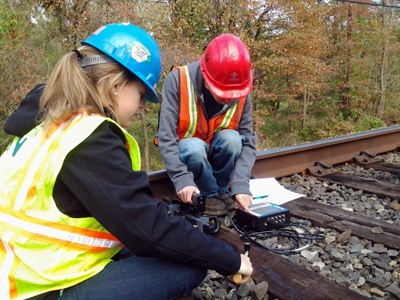Civil Engineering Professor Makes Inroads in Transportation Industry

Pluimer and Stefanowicz take soil samples.
Leslie Myers McCarthy, PhD, PE, is making a name for herself in the field of transportation engineering. An assistant professor of Civil and Environmental Engineering at Villanova University, the National Cooperative Highway Research Program (NCHRP) Project 04-39, "Field Performance of Corrugated Pipe Manufactured with Recycled Polyethylene Content," is one of several active studies on Dr. McCarthy's plate. With co-PI Andrea Welker, PhD, PE, professor of Civil and Environmental Engineering, and prime contractor TRI/Environmental Inc., the research team will investigate pipe contaminants and their correlation to stress cracking performance, expected service life, load and resistance factor design methodology and strain limits, as well as material and construction specifications to accommodate the use of recycled content. Drs. McCarthy and Welker, along with PhD student Michael Pluimer and undergraduate research assistant Christine Stefanowicz '14 CE, will be heavily involved in laboratory and on-site pipe and soil testing, and finite element analysis of pipe behavior under railroad loading.
Although the main focus of the NCHRP project is on corrugated plastic pipes under highways, the NCHRP expert panel was intrigued by Pluimer's idea of including a field investigation of loading under an active railroad. At about the same time, the Southeastern Pennsylvania Transit Authority (SEPTA) had become interested in this research idea in light of its sustainability initiative. Recognizing the benefit of working with Villanova to evaluate the use of plastic pipes made with recycled materials for railroad applications, SEPTA initiated a pilot study, which included the test pipe installation that took place earlier this fall. The pilot study includes both instrumented corrugated plastic pipe made with virgin resin and made with recycled materials, placed adjacent to each other underneath SEPTA's Doylestown commuter rail line. This is the first corrugated plastic pipe made with recycled materials installed underneath one of SEPTA's live tracks. The future of the use of corrugated plastic pipes on SEPTA’s infrastructure will be determined in part through the results of a cost-benefit analysis conducted by Drs. McCarthy and Welker, along with Peter Zalesky, PhD, an economics professor in the Villanova School of Business.

Stefanowicz and Trieu measure veloctity waves.
In addition to the opportunity for cross-college collaboration with VSB, Dr. McCarthy points out other Villanova connections to this project: "Villanova Civil Engineering alumnus and advisory board member Robert Lund '78 CE, '81 MSCE has been one of our biggest supporters at SEPTA. Our PhD student, Michael Pluimer, is Principal Investigator for TRI/Environmental. And Chrissy is developing an undergraduate research report from the work."
One of the aspects of the project that most pleases Dr. McCarthy is its alignment with the College's initiative to increase national recognition. She expects the study to result in at least one peer-reviewed journal article, related conference proceedings and regional meetings as suggested by SEPTA. Dr. McCarthy also sees the project as a terrific opportunity to continue to enhance the University’s reputation in railroad engineering. "The research opportunities will advance the goal of expanding the railway curriculum at Villanova, and at the same time provide learning opportunities for undergraduate and graduate students." As evidence of growing respect for the University's railway engineering expertise, Villanova was recently invited to join the NURAIL consortium as an affiliate university member through the US Department of Transportation and Federal Railroad Administration. "As a large number of older professionals in this field are expected to retire over the next decade, we need to educate a new generation of engineers to take their place. We introduced railroad engineering in 2009, and our program continues to mature and grow."
In addition to NCHRP Project 04-39, Dr. McCarthy’s current research includes:
- A Federal Highway Administration (FHWA) MAP-21 (Moving Ahead for Progress in the 21st Century Act) comprehensive Truck Size and Weight Limit study
- A performance-related specification program for the Rhode Island Department of Transportation
- Flooded pavement assessments for the FHWA
- An investigation into the use of modified asphalt mixtures in airfield aprons and taxiways for the Federal Aviation Administration
In addition, she and Civil and Environmental Associate Professor Frank Falcone are directing senior-level students in the Professional Practices in Engineering course as they take on a Delaware Valley Regional Planning Commission highway-railroad grade crossing study in nearby Darby Borough.
